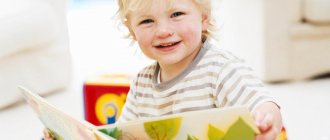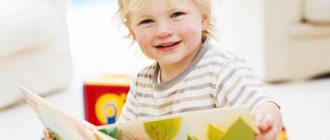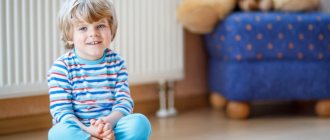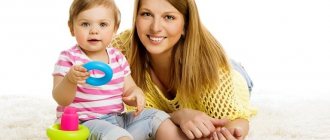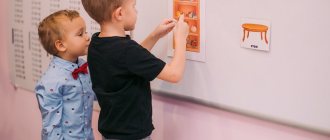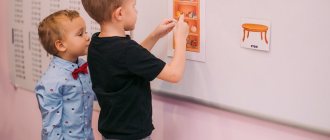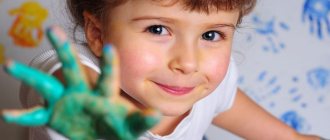A new stage is coming in his, and in your life. The literature on psychology and pedagogy usually talks in detail about the first year of life, since it is then that the most significant changes in a child’s development occur, and then about three-year-olds, because it is at three years that the famous psychological crisis occurs. But the period from one to two years is no less important in personality development.
The baby can already understand a lot, but it is still very difficult for him to express his thoughts and desires in words. And how much I want to say! Help him. To do this, you need to purposefully develop the speech of your little one. The better you understand each other, the less reason the baby will have for whims and hysterics.
Let's figure out how speech develops at this age.
Stage one: first words
From a year to a year and a half, the baby begins to move very actively in space and accumulate new experiences. This experience is necessarily reflected in speech development.
Usually the first words appear at the age of 9.5 months - 1 year 6 months. Most often they designate the closest people: mother, father, woman, uncle, aunt. The baby can easily reproduce onomatopoeic words: aw-aw (dog), tick-tock (clock), mu-mu (cow), etc. Often, instead of a whole word, a child pronounces an initial or stressed syllable (ko instead of cat or bura instead of Cheburashka). But since these “words” mean specific things and are pronounced in a certain situation (at the sight of a cat or Cheburashka), we can call them words, and not random syllables.
It has been noticed that some children “love” nouns denoting objects and people more, while others prefer verbs associated with social interaction – “go away”, “want”, “give”, etc.
The first words have a broad generalized meaning. However, this is not at all the generalization that we are used to when calling a doll, a bear and a ball as toys. For now, the child singles out one feature and combines a variety of things based on it. So, the word “yum-yum” is used by a one-year-old child to describe all kinds of food, as well as the dishes from which he is fed. When he gets hungry, he also shouts “Yum-yum!” (=I’m hungry!), and when he sees a teenager chewing gum on the street, he comments: “yum-yum” (=eating).
Little Lisa used the word “una” (moon) to call all round-shaped objects - pancakes, round spots on window glass, circles in books, postmarks on envelopes, round embossed frames on book bindings, the letter “O”. And Fedya decided to generalize the sounding objects. The word “ko-ko”, which at first in his dictionary meant a crowing rooster, Fedya began to call the sounds of a violin, piano, accordion, any music and musical toys. Texture can also become a general principle: the word “woof-woof” was used by Katyusha not only for a dog, but also for all furry animals, soft slippers, and even a photograph of an old man in a fur coat.
Speech development in a child at 2 years old
At the age of 2, the child begins to inform his parents at every opportunity about his own: “I love and don’t like,” “I want and I don’t want.” The average vocabulary of a 2-year-old child is about 50 words, although some children are capable of knowing many more words.
By the age of 2, the child should:
• speak in simple short phrases (2-3 words);
• correctly understand parents' requests;
• carry out simple instructions, such as: give a napkin, bring a ball, put it on a chair, do not get out of bed.
"Y?"
During this same period, children are very fond of pointing with their finger at an object that interests them with the question word “Y?”. Parents are often annoyed by this; they believe that it is indecent to behave this way. But such a gesture is very important for speech development! Do not forbid doing this under any circumstances, and, moreover, help the baby master such a gesture if necessary.
The famous Russian psychologist L. S. Vygotsky believed that the pointing gesture was originally simply a failed or unfinished grasping movement. “The child is trying to grab an object that is too far away; his hands, extended to the object, remain hanging in the air... There is a movement here that objectively points to the object, and nothing more. But when the mother comes to the child’s aid and interprets his movement as an instruction, the situation changes significantly. The pointing gesture becomes a gesture for others.”
Thus, the baby makes an amazing discovery: everything around has its own name - everyone, every object! "Y?" with a pointing gesture is a greedy question: “What is this?” This is a cat, and this is a house, and this is a big dump truck... Passive vocabulary (i.e. words that a child understands, but cannot reproduce himself) is becoming richer each time, and someday it will certainly turn from passive into active (active vocabulary is the words that the child pronounces).
Cognitive development of a child at 2 years old
At 2 years old, a child should be able to:
• understand speech, stories and fairy tales well (of course, aimed at children of this age);
• copy the movements of your favorite toys - bears, dolls, monkeys;
• recognize familiar objects in pictures and name them;
• solve simple card puzzles (3-4 cards);
• name the objects shown in the pictures;
• count from 1 to 3 and understand the meaning of these numbers;
• be able to show your age on your fingers;
• know that the child is a boy or a girl.
Tactics of your actions
As before, the main thing is to communicate with your baby! Having caught his interested glance or pointing gesture, name the objects that surround you and comment on your actions. Don’t be shy about talking out loud and on the street - it’s very important for your baby to hear from you what’s happening in the sandbox, where passers-by are rushing, and what color that beautiful aunt’s dress is.
Try to ensure that your comments do not remain only sound, but have some kind of reinforcement in bodily sensations and movement. The baby will remember the word “tree” much better if he touches the rough bark with his palm, the word “handkerchief” - when he tries to tie a scarf on a doll, the word “bell” - if he rings a real bell.
Try to “introduce” a new word to your child in various combinations with other words and objects. For example, when showing milk, show what it looks like in a glass or in a pan in which you are going to cook porridge. Comment on your actions: “Mom pours milk into a glass”, “white milk, delicious”, “drink milk”, etc.
It is useful to consider and discuss not only various objects, but also pictures with their images. After all, by this age, children are already quite good at identifying an object and its image. Compare real things with pictures. What do they have in common and how do they differ? For example, if you see a photograph of a girl in a red hat in a magazine, find your baby’s hat and compare: “The girl has a hat, and Alyosha has a hat. The girl’s hat is red, and Alyosha’s is yellow,” etc.
Height and weight standards
The child is 18 months old, what should his “ideal” weight and height be? Each baby develops and grows according to its own “individual plan”, so it is impossible to give exact numbers, there is only a range of values that you can rely on. Below is a table showing the approximate weight of boys and girls, as well as their height at 18 months.
| Index | Development in boys at 18 months | Development in girls at 18 months |
| Weight | 8.8 kg – 13.7 kg | 8.1 kg – 13.2 kg |
| Height | 76.9 cm – 87.7 cm | 74.9 cm – 86.5 cm |
Your pediatrician will be able to fully assess the baby’s development, since height and weight alone cannot make a conclusion about the normal development.
First generalizations
Gradually, the baby establishes a connection not only between a specific object and a word, but also between other similar objects and this word. How does this happen?
Here, for example, is an experiment that was conducted by psychologists with young children.
The experiment involved two groups of children aged from 1 year to one year and 3 months. In the first group, each child for two months, almost every day, was shown an unfamiliar object - a book - 10 times for five seconds and said: “Book! Book!" Each time the children turned their gaze and turned their heads towards the object. During the observation period, this reaction was repeated 500 times.
With the children of the second group, one book was also used, but the child, under the guidance of an adult, performed various actions with it. “Here is a book!”, “Open the book!”, “Close the book!” etc. The kids were given only 20 different commands; each of them included the word “book”, and each required a specific motor response. These motor reactions were repeated only 50 times during the entire observation period.
Control tests were then carried out in both groups. During these tests, many different objects were laid out in front of the child: cubes, dolls, toy animals, several books that differed in size, thickness, cover color, etc. The adult addressed the child with the words: “Give me the book!” It was important to find out which book the child would choose. Only the one he saw before, or any other, uniting the objects with the concept of “book”? Children from the first group took only one book - the one they had seen during the previous two months - and gave it to the experimenter. When they were asked to take another book, they either took the first object they came across (it could be a doll, a hare, etc.) or did nothing. This means that for the children of this group the word “book” remained the name of one specific object and did not acquire a general meaning. So a large number of repetitions, even with the simultaneous presentation of the corresponding object, does not yet contribute to the development of generalization.
And therefore, teach your baby to act with various objects, be sure to name these actions out loud. You can bring the same book, show it to the doll, open it, close it, leaf through it, put it on a chair, find an interesting picture in it, etc. Contact your baby more often with various simple requests. He will be very happy to help you, and at the same time he will enrich his vocabulary and gain the first experience of generalization.
Daily regime
Dream.
At the age of 18 months, the child sleeps less than before - approximately 14 hours a day. The bulk of the allotted time (10-11 hours) is spent sleeping at night, and the child sleeps during the rest of the hours during the day. As a rule, there is only one nap during the day, but some babies still go to bed twice during the day.
Walks.
It is recommended to go for walks several times a day, at least once. If the weather permits, you can walk as much as the child and parents want; in particularly windy or rainy weather, it is better to stay at home.
Nutrition.
Meals are set to five times a day. It is not recommended for a child to fast for more than four hours; meals should be taken at approximately the same time. If your baby has not yet been weaned, now is the time to start this process. New foods appear in the child’s diet, the diet becomes more varied, but it is still worth abstaining from harmful foods.
If the child is bottle-fed, or you are weaning him from the breast, special attention should be paid to the formula; it must meet the child’s needs. An excellent option is to feed on goat milk Kabrita 4. The mixture has a balanced composition and is intended for children from 18 months. In addition, the Kabrita line includes purees, which will also be an excellent option for diversifying your baby’s diet.
Nursery rhymes and jokes
In a sense, various nursery rhymes and jokes are ideal first literary texts that a child perceives literally with mother’s milk. After all, they describe real life experiences, the world around them, comment on various natural phenomena, etc. At the same time, the clear rhythm and melodiousness of nursery rhymes help the child easily learn new concepts and sometimes do what he doesn’t really want, but is necessary. For example, you can wash your face with this nursery rhyme:
- Some water, some water, wash Vanya’s (Masha’s) face,
- To make your cheeks blush, your eyes to shine,
- So that the mouth laughs, so that the tooth bites.
At the same time, we will teach the first lesson on the structure of the body and show where our face, cheeks, eyes, mouth and teeth are. Then, after washing your face, you can repeat the nursery rhyme again, this time depicting how to wash your face, not forgetting about your eyes or cheeks.
Your baby is a little one, and feeding him is a big problem? Perhaps another nursery rhyme will come to the rescue:
- The donut, the flatbread, was sitting in the oven, looking at us, and wanted to put it in her mouth.
Or this:
- I’ll bake Tanya a pie,
- I’m already blushing for my granddaughter.
- It has a wheat crust,
- And the filling is egg,
- And the honey shaving brush,
- My granddaughter is in trouble.
- These nursery rhymes can be read while eating.
- When putting a shirt on your baby, say:
- Aunt Agashka, sew me a shirt:
- I need to dress up and go for a ride!
They also tell nursery rhymes about natural phenomena. For example, about rain:
- Rain, rain, more!
- We'll give you the grounds
- We'll give you a spoon:
- Sip a little!
And try to “drive away” the lingering rain with this nursery rhyme:
- Rain, rain,
- Pour it full,
- Get the little kids wet!
Nursery rhymes also emphasize the baby’s new skills: for example, learning to walk:
- Katya, Katya, little,
- Katya is remote,
- Walk along the path
- Stomp, Katya, with your little foot.
Or:
- Bunny, walk around,
- Gray, walk around,
- Like this, like this
- Like this, like this!
The first steps, of course, cannot be imagined without numerous falls and bruises. Stroke the bruised area, saying:
- The cat is in pain
- The dog is in pain
- And Andryusha is not in pain,
- Andryusha's pain will fly away to the birch tree.
In this kind of nursery rhymes there is, among other things, a deep psychotherapeutic meaning. They allow you to take your mind off the pain, and therefore relieve the tension associated with pain. Such psychological treatment is quite effective for the baby.
By the way, did you know that perhaps the most famous finger game, “Magpie-Magpie,” did not end with the wiggling of the idle little finger:
- You didn't chop wood
- Didn't carry water
- There will be no porridge for you.
The game has a sequel. Adult says:
- I went looking for it myself:
- The water here is cold (stroking the baby’s wrist),
- It’s warm here (stroking her elbow),
- It's hot here (stroking her shoulder),
- And here - boiling water, boiling water, tickling! (adult tickles child under arm)
After all, the point of this nursery rhyme is not only the development of fine motor skills. It gives the child the joy of physical contact, the opportunity to feel his fingers, elbow, shoulder, and ultimately, to form an idea of his body.
There are special nursery rhymes for putting a child to sleep. They can become part of your ritual that gets your baby ready for bed. For example, you can put a fluffy toy kitten in the crib, which will “cradle” its little owner:
- Come, little kitten,
- Come, little gray tail,
- Come, cat, spend the night,
- Come and play with Dashenka.
- How am I for you, cat?
- I will pay for the work:
- I'll sew a new fur coat
- And I'll order boots.
Health of a one-year-old child
A visit to the pediatrician every year is considered a mandatory procedure. The doctor takes the necessary tests from the child and makes physiological measurements. The issue of child vaccination is also being addressed. It is also necessary to visit the following specialists: neurologist, surgeon, orthopedist. Additionally, it is advisable to consult an ophthalmologist and dentist.
An important component of a healthy lifestyle is maintaining the child’s personal hygiene. At one year of age, a baby can learn to wash his hands before eating and after a walk, as well as wash himself. If a child has grown at least 1 tooth, it is worth making friends with a toothbrush. And, of course, do not ignore evening bathing and rinsing in the shower.
Stage two: first phrases
In fact, the first phrases, strange as it may sound, were already contained in single words. After all, single words for a baby are a whole complex of different ideas. Thus, the word “mama,” pronounced in different situations, with changing intonation and accompanied by different gestures, can mean: “I want to go to my mother,” “Mom, tie my lace,” or “Here is my mother.” The child found a beautiful button on the floor, picked it up and invited his mother to admire it: “Mom! Mother!" And when he fell, his plaintive whimper also sounds: “Ma-ma-a-a!”
However, after your baby turns one and a half years old, you will most likely hear his first “real” phrase: “Mom, give me!” or “Dad, go!” etc. At approximately 1 year 8 months - 1 year 10 months, the baby well masters the imperative mood of the verb and plural forms, and by two years - the case forms of nouns (although this process will finally end by 3-4 years).
In girls, the combination of words into phrases occurs a little earlier, in boys - two to three months later. After the first phrase is uttered, speech development usually proceeds very rapidly. Almost every day you can hear more and more new phrases from your baby. However, keep in mind that the baby, as before, needs your attention and response. If there is no answer or it is monosyllabic and not emotional, then interest in speech activity is lost and development is inhibited.
It is very important to show your child that you understand him and to “translate” his first awkward words into ordinary, correct adult language.
Here's an example. Mom is preparing dinner in the kitchen. The baby watches her, sitting on a high chair.
"But!" - says the baby, seeing the knife with which his mother is going to cut vegetables. “Yes, it’s a knife,” my mother agrees.
"Get sick!" – adds the child.
“Big knife,” mom “translates,” imperceptibly combining both words into a phrase, and adds: “We’ll cut the cabbage with a big knife.” Such a “translation” will contribute to a faster and more successful combination of words into a sentence.
Don’t be afraid of “wrong” baby words, they will definitely turn into “real” ones someday. Appreciate the child’s attempt, even if not yet very successful, to share his life experience with you. This will give him confidence in his abilities and a feeling of being understood.
What problems may arise
By 18 months, the baby should be able to walk without support, but some children start walking too late; in any case, the child should already be taking confident steps.
If the child still has not begun to speak his first words, it is worth contacting a specialist, since normal physical development at one and a half years includes the pronunciation of a certain number of words.
In order for a child to develop normally at 18 months, proper care, constant attention and daily developmental activities are necessary.
Share on social media networks
Story play and speech
It happens that a child between the ages of one and two does not speak and does not play at all. In this case, first of all, try to teach him to play.
At first glance, it seems that the story game has nothing to do with the development of speech. However, in reality this is not entirely true. A one-year-old child not only communicates his desires and problems through speech, he also tries to share his impressions with an adult. So, when a baby points his finger at a car, he wants to say: “I saw a car, look at it too!” But in order to name any objects, the child needs to remember them. Moreover, remember not as abstract concepts, but as experienced through your own experience. And the simplest plot game will help him with this - feed the doll, put it to bed, sing it a lullaby, walk with it along the path. With the help of real, simple actions, the child works through his experience in play, and this experience is consolidated in speech. If before the child did not seem to notice what he was doing, now he pays special attention to the actions. And therefore, story games that repeat the actions of the baby himself must be commented on: “The bunny walks, jumps, digs with a shovel.” Show your child how to play with this or that toy, and soon he will begin to repeat your play stories.
You can compose and show your child simple and short scenes with toys. For example, a bear fell and cried, or a doll lost a ball and is looking for it. Ask your child to help his little friends.
The same nursery rhymes and jokes that we talked about above can be played with toys. For example, like this:
- Big feet walked along the road:
- To-o-op, to-o-op, to-o-op, to-o-op (pronounced slowly, in a low voice).
- Little feet ran along the path:
- Top-top-top, to-o-op (pronounced in a high voice and quickly).
Compare the baby’s leg and the adult’s leg, show how one walks. Now find two similar toys of different sizes (two bears, bunnies or dolls), build different paths for them from cubes (wide and narrow) and let your toy characters walk either slowly or quickly. See how many concepts a child will learn from such simple fun: big, small, slow, fast, wide, narrow!
Physical development of a child at 2 years old
At two years old, a child should be able to:
• stand boldly on your feet;
• do not run fast without stumbling;
• easily jump up using two legs;
• climb the stairs independently while holding onto the railings;
• stand on your left or right leg for several seconds while holding your body weight;
• move in circles and zigzags;
• confidently hold a pencil with your left or right hand;
• eat carefully using a spoon;
• build towers from 7-8 blocks;
• play ball (kick, throw).
Nimble fingers
Training fine finger movements has a great influence on the development of a child’s active speech. This phenomenon has long been known to psychologists and speech therapists. And they never tire of repeating how important it is to develop fine motor skills. A variety of finger games, manipulations with paper (it can be torn into small pieces, crumpled, crumpled), and unscrewing and tightening the lids on cans and bottles will help with this.
As always, an inexhaustible resource in this regard is an ordinary kitchen. My child, for example, really liked hiding small toys from Kinder Surprises in a bowl of dry peas or lentils, and then finding them by touch (be careful, Kinder Surprises often contain small parts that, of course, should not be given to the baby). The peas gently massage little fingers, and the baby receives many pleasant tactile sensations. Try it yourself!
You can draw with your fingers on a tray on which a thin layer of flour or semolina is sprinkled. You can play with cotton swabs, taking them out of the jar one at a time and then putting them back in. You can attach colorful clothespins to a plastic jar or box, and then unhook them and throw them into the same jar.
Look around, and perhaps you will find a new interesting and useful activity for your little one.
Development activities
You need to work with kids: this has a beneficial effect on their development and helps in later life, including in adulthood [2]. This way, the child will begin to learn new skills and knowledge faster, which will subsequently help him with his studies and allow him to better and faster understand the surrounding reality. Remember that at this age you need to gradually give your baby more independence, for example, allow him to choose what blouse he will wear or what book he will read at night. Try to hold your child in your arms as little as possible so that he has an incentive to get to the right place on his own.
Music.
Children love musical toys, nursery rhymes and melodies. In addition, the more variety of pleasant sounds the baby hears, the more developed his hearing will be. Therefore, play children's songs, melodies and selections that are specially designed for young children. In addition, it will be easier for the baby to play to music; he may want to dance, thereby developing motor activity, or sing along - this promotes speech development. Of course, if he doesn’t like a certain melody (at this age children are already beginning to acquire their own preferences), it is better not to turn it on, but to turn on the one that suits his taste.
Dialogues and reading.
The more you talk to your child, the more words you use in dialogues, the more extensive his vocabulary will be. Long conversations with your baby promote speech development. Try to communicate with your child the entire time you spend with him: describe the objects he is looking at, while walking, point out various things and phenomena that interest the child and say their names. Try to communicate with your baby based on his childhood speech capabilities. When talking, name the words clearly and distinctly, so that it is easier for the child to remember them and repeat them, use soft and affectionate intonations: a child at this age perfectly recognizes and feels the mood of others. You can and should read little books. He himself is at this age
The baby doesn't speak. What to do?
In our conversation about speech development from 0 to 12 months, we already talked about the need to be careful with the currently fashionable early learning. This also applies to ages from one to two years. Sometimes parents, literally from the cradle, begin to introduce their baby to geometric shapes, letters, numbers, while forgetting about real, life objects and situations surrounding the child. After all, letters and numbers are an abstraction that is only possible as a result of extensive experience, and the child does not have it, just as there is no physiological possibility for abstractions of this level.
His brain is not yet mature for such actions. As a result of such early training, the child’s speech development strays from the course laid down by nature. In this case, it’s worth taking a break from the numerous cubes and complex intellectual programs for a while. Walk, play, let your communication be lively and emotional. For a child now this is much more important than all the newfangled methods of early intellectual development.
If your child has not started speaking by the age of two, first of all, try to find out if he is trying to communicate in some other way - using gestures, intonation, “gibberish” language. In this case, the first “real” words are most likely about to appear. If the baby does not try to establish contact with the outside world, parents often notice other characteristics of the child: he plays the same template games, repeats stereotypical movements, does not always respond to his name, does not look into the eyes, does not respond to many questions addressed to him, does not feel your condition. Often in such children, speech development is difficult and late. Particular attention should be paid if the child previously tried to communicate with you and other children, and then suddenly stopped doing this.
In this case, without delay, seek help from a good psychologist.
Good luck and patience, and very soon you will have full-fledged dialogues with your baby.
Inessa Smyk
Based on materials from the magazine "Aistenok"
Physiological changes
Starting from one year of age, the growth rate will slow down slightly. This is completely normal: only in the first 12 months of life the baby grows so rapidly, then the process will become a little less rapid.
Weight loss.
Strictly speaking, weight itself does not decrease - only the rate at which it increases. The baby plumpness is gradually starting to go away, but some of it still remains. Over time, the baby will gain weight more slowly, and this indicates his normal development.
Teeth.
At the age of one year, a baby already has several teeth erupting - on average up to 8. It is worth showing the child to the doctor if he has not developed a single baby tooth in one year. When they cut, the baby becomes restless and often has trouble sleeping at night: he feels uncomfortable and this makes it difficult to sleep. Doctors give recommendations on how to reduce discomfort for a child during teething.
Feet.
The baby’s teeth are still flat and no bend has appeared on them. This will pass over time when the child gets used to walking on his own, and then the fat pads on the feet will disappear. If the baby has already begun to actively walk, the pads may disappear earlier, and a healthy bend will begin to appear on the legs. The doctor will examine the baby’s legs during a routine check-up, and he will tell you if everything is fine with them.
Sources
- Wu Y., Li G., Zheng Y. . // Lin Chung Er Bi Yan Hou Tou Jing Wai Ke Za Zhi - 2022 - Vol35 - N4 - p.341-345; PMID:33794634
- Voitenkov VB., Komantsev VN., Klimkin AV., Ekusheva EV., Skripchenko NV., Bedova MA. // Adv Gerontol - 2022 - Vol33 - N5 - p.1002-1006; PMID:33550760
- Liu X., Zhong R., Kusuma L., Li N., Tang W. Determining social power: Do Chinese preschoolers integrate verbal and nonverbal cues? // J Exp Child Psychol - 2022 - Vol204 - NNULL - p.104943; PMID:33360276
- Ganc M., Kobosko J., Jedrzejczak WW., Kochański B., Skarzynski H. Psychomotor development of 4-year-old deaf children with cochlear implants: Three case studies. // Int J Pediatr Otorhinolaryngol - 2022 - Vol141 - NNULL - p.110570; PMID:33348125
- Fordington S., Brown T.H. An evaluation of the Hear Glue Ear mobile application for children aged 2-8 years old with otitis media with effusion. // Digit Health - 2022 - Vol6 - NNULL - p.2055207620966163; PMID:33194218
- Jasińska KK., Shuai L., Lau ANL., Frost S., Landi N., Pugh KR. Functional connectivity in the developing language network in 4-year-old children predicts future reading ability. // Dev Sci - 2021 - Vol24 - N2 - p.e13041; PMID:33032375
- Tan LT., Nathan AM., Jayanath S., Eg KP., Thavagnanam S., Lum LCS., Gan CS., de Bruyne JA. Health-related quality of life and developmental outcome of children on home mechanical ventilation in a developing country: A cross-sectional study. // Pediatr Pulmonol - 2022 - Vol55 - N12 - p.3477-3486; PMID:33002341
- Vilela N., Sanches SGG., Carvallo RMM. Development of auditory perception in preschool children. // Int J Pediatr Otorhinolaryngol - 2022 - Vol129 - NNULL - p.109777; PMID:31756662
- Wang J., Joanisse MF., Booth JR. Neural representations of phonology in temporal cortex scaffold longitudinal reading gains in 5- to 7-year-old children. // Neuroimage - 2022 - Vol207 - NNULL - p.116359; PMID:31733372
- Wu Y., Li G., Ma Y., Zheng Y. . // Lin Chung Er Bi Yan Hou Tou Jing Wai Ke Za Zhi - 2022 - Vol33 - N10 - p.918-922; PMID:31623034
Behavioral problems of one-year-old children and ways to solve them
Children's tantrums are a topic to which serious scientists devote scientific articles. Their real reasons most often lie in a combination of the child’s personal qualities, immediate circumstances and behavioral development processes.
It is tantrums that occur more often in children from 2 years of age, but 12 months is the boundary between the period of infancy and early childhood, when the worldview changes. The child begins to realize himself as an individual, his own will is formed. For the child’s psyche, this is a difficult test, because, although aware of his “wants”, as well as the difference between “possible” and “impossible”, the child does not yet understand the reasons for the prohibitions.
In a year, the first age crisis occurs, and childish stubbornness also makes itself felt.
Crisis of 1 year of life
If your usually accommodating child began to express his desires in the form of whims and hysterics, there was a clear tendency towards touchiness, tearfulness, and stubbornness - these are signs of a psychological crisis in the first year of life. Additionally, the child is upset that attempts to do something on his own lead to failures, because he is not yet physically developed enough.
At this stage you need to be patient. The main task is not to react aggressively to the child’s behavior and learn to set boundaries for what is permitted.
What should parents do when their child has a crisis in the first year of life?
- Set boundaries. There should not be too many prohibitions, but they must be constant - what is not allowed is always not allowed, unless the parents allow it - none of the relatives/teachers allows it.
- Allow your child to take the initiative and do accessible things on their own, helping if necessary. This will strengthen his self-confidence.
- Don't force feed. Many people refuse to eat during their first age crisis. Even if you have a meal schedule, do not force your child to eat through hysterics. Offer him food when he asks.
- Whenever possible, comply with your child's requests. Attention and confidence in the help of parents increases the child’s trust in the world.
- Ask for help. The opportunity to help parents pleases the child and brings him pleasure. Praise from loved ones is an important emotional factor in development.
- Don't feed the hysteria. Do not shout or try to forcefully stop this behavior. Realizing that the manipulation does not work, the child will calm down.
- Distract your child from negative emotions, but do not indulge his weaknesses by giving him sweets at the slightest sign of an emotional outburst, do not pick him up on demand and do not use gadgets for this.


